Papers by Adrie Straathof

Industrial & Engineering Chemistry Research, 2009
Integration of fermentation and downstream steps is required to improve the sustainability of ind... more Integration of fermentation and downstream steps is required to improve the sustainability of industrial biotechnology processes. In this context, a new integrated process for -lactam nuclei production is proposed, which has been theoretically investigated and conceptually designed. This process is an integration of fermentation and enzymatic deacylation of adipyl-7-aminodeacetoxycephalosporanic acid (adADCA) in one reactor producing 7-aminodeacetoxycephalosporanic acid (ADCA) directly from glucose. Although the deacylation equilibrium is unfavorable at the fermentation pH, it is pulled to completion because ADCA starts to crystallize and the liberated side chain, adipic acid (AA), is consumed by the fermentation. Therefore the integrated process requires much less AA than the nonintegrated process. In addition, the new process will lead to a reduction in number of downstream processing units, should avoid the use of acids and bases for pH shifts, and might lead to a reduction in waste salts production. A conceptual process was designed including an economic and technical analysis. The design goal was to produce 2000 tons/year of ADCA of 99% purity. Rigorous simulations were performed to evaluate different process options. Among the economic advantages of the new integrated process are 13.4% lower capital investments and 7.8% lower manufacturing costs. An analogous process for 6-aminopenicillanic acid (APA) is not feasible due to chemical degradation of this product.
Organic Process Research & Development, 2006
ABSTRACT
We have developed an experimental method applying confocal laser scanning microscopy (CLSM) which... more We have developed an experimental method applying confocal laser scanning microscopy (CLSM) which, for the first time, can describe the solute distribution in protein crystal simultaneously as function of space and time without damaging the crystal. The essential advantage of CLSM is its ability to discriminate unwanted out-of-focus light that limits the application of a normal light microscope to obtain
International Journal for Numerical Methods in Engineering, 2012
Isobutene (2-methylpropene) is one of those chemicals for which bio-based production might replac... more Isobutene (2-methylpropene) is one of those chemicals for which bio-based production might replace the petrochemical production in the future. Currently, more than 10 million metric tons of isobutene are produced on a yearly basis. Even though bio-based production might also be achieved through chemocatalytic or thermochemical methods, this review focuses on fermentative routes from sugars. Although biological isobutene formation is
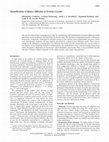
The Journal of Physical Chemistry B, 2005
The use of confocal laser scanning microscopy for visualization and quantification of binary diff... more The use of confocal laser scanning microscopy for visualization and quantification of binary diffusion within anisotropic porous material is described here for the first time. The dynamics of adsorption profiles of dianionic fluorescein, zwitterionic rhodamine B, and their mixture in the cationic native orthorhombic lysozyme crystal were subsequently analyzed. All data could be described by a classical pore diffusion model. There was no change in the adsorption characteristics, but diffusion decreased with the introduction of a second solute in the solution. It was found that diffusion is determined by the combination of steric and electrostatic interactions, while adsorption is dependent on electrostatic and hydrophobic interactions. Thus, it was established that the outcome of binary transport depends on the solute, protein, and crystal characteristics.
Tetrahedron, 1999
Lipase-catalyzed direct amidation of free carboxylic acids is possible with ammonia in organic so... more Lipase-catalyzed direct amidation of free carboxylic acids is possible with ammonia in organic solvents. For butyric acid as a model compound the reaction proceeds well despite precipitation of ammonium butyrate, provided that the added molar amounts of butyric acid and ammonia are in the same range. The addition of ammonium salts is a convenient way to ensure suitable ammonia concentrations.
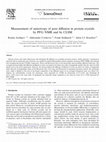
Microporous and Mesoporous Materials, 2008
Solvent (water) and solute (fluorescein and rhodamine B) diffusion in crystalline lysozyme protei... more Solvent (water) and solute (fluorescein and rhodamine B) diffusion in crystalline lysozyme protein, which represent a mesoporous material with an anisotropic pore structure, was studied by pulsed field gradient nuclear magnetic resonance (PFG NMR) and confocal laser scanning microscopy (CLSM), respectively. Water and fluorescent dyes reveal anisotropic intracrystalline diffusion behaviour. The averaged intracrystalline self-diffusion coefficient of water was found to be about one order of magnitude smaller than the value for bulk liquid water at the same temperature. However, the intracrystalline self-diffusion coefficients of water are about two orders of magnitude faster than the corresponding values of the fluorescent dyes. For water and fluorescein in tetragonal lysozyme crystals, the anisotropy ratio, which is defined as the ratio of the largest component of the diffusion tensor to its averaged orthogonal value, was about 0.16, whereas for orthorhombic crystals the anisotropy ratios measured by CLSM for fluorescein (0.15 ± 0.03) and rhodamine B (0.25 ± 0.05) were in the same order of magnitude but somewhat larger compared to the value for water (0.11 ± 0.04) measured by PFG NMR.
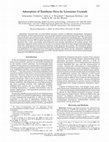
Langmuir, 2005
Adsorption characteristics of cross-linked lysozyme crystals of different morphologies (tetragona... more Adsorption characteristics of cross-linked lysozyme crystals of different morphologies (tetragonal, orthorhombic, triclinic and monoclinic) were examined using four anionic dyes (fluorescein, eosin, erythrosin, and rose bengal), one zwitterionic dye (rhodamine B), and one cationic dye (rhodamine 6G). The adsorption isotherms were of the Langmuir type for all examined systems with the exception of rhodamine B adsorption by monoclinic crystals. The weakest adsorption was observed for the cationic dye, rhodamine B, whereas dianionic dyes, eosin, rose bengal, and erythrosin were strongly adsorbed on the protein surface. The adsorption capacities of the crystals for the dyes were found to depend on both charge and hydrophobicity of the dye, reflecting the heterogeneous character of the lysozyme pore surface. The adsorption affinity of the crystals for the dyes was a function of the dyes' hydrophobicity. Furthermore, the crystal morphology was identified as an additional factor determining capacity and affinity for dye adsorption. Differences between crystals prepared in the presence of the same precipitant were lower than between morphologies prepared with different precipitants.
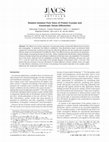
Journal of the American Chemical Society, 2005
The diffusion of a solute, fluorescein, into lysozyme protein crystals with different pore struct... more The diffusion of a solute, fluorescein, into lysozyme protein crystals with different pore structures was investigated. To determine the diffusion coefficients, three-dimensional solute concentration fields acquired by confocal laser scanning microscopy (CLSM) during diffusion into the crystals were compared with the output of a time-dependent 3-D diffusion model. The diffusion process was found to be anisotropic, and the degree of anisotropy increased in the order: triclinic, tetragonal and orthorhombic crystal morphology. A linear correlation between the pore diffusion coefficients and the pore sizes was established. The maximum size of the solute, deduced from the established correlation of diffusion coefficients and pore size, was 0.73 ( 0.06 nm, which was in the range of the average diameter of fluorescein (0.69 ( 0.02 nm). This proves that size exclusion is the key mechanism for solute diffusion in protein crystals. Hence, the origin of solute diffusion anisotropy can be found in the packing of the protein molecules in the crystals, which determines the crystal pore organization.

Journal of Molecular Catalysis B: Enzymatic, 2001
The enantioselective synthesis of cyanohydrins catalyzed by R-hydroxynitrile lyase in an aqueous-... more The enantioselective synthesis of cyanohydrins catalyzed by R-hydroxynitrile lyase in an aqueous-organic liquid two-phase system using, mass transfer limitation to enhance enantiomeric excess at 5 • C and pH 5.5 is described. Benzaldehyde, a good substrate, and cinnamaldehyde, a notoriously difficult substrate, were used as model substrates and compared in order to establish the mass transfer limitation concept in a two-liquid phase system, where the non-enzymatic-racemic reaction competes. Enzyme concentration and phase volume ratio between organic and buffer phase were geared to one another to enhance the enantiomeric excess for each substrate. In both cases, after optimization, excellent chemical conversion (>99% on a 60 mmol scale), high throughput and high enantiomeric excess (benzaldehyde >99% and cinnamaldehyde >96%) were achieved.
Journal of Molecular Catalysis B: Enzymatic, 2004
... Juliana S. Ferreira a , b , Adrie JJ Straathof a , Corresponding Author Contact Information ,... more ... Juliana S. Ferreira a , b , Adrie JJ Straathof a , Corresponding Author Contact Information , E-mail The Corresponding Author , Telma T. Franco b , Luuk AM van der Wielen a. ... The pH was kept constant, using 0.250 M KOH in a digital burette. ...
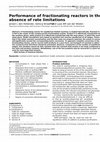
Journal of Chemical Technology & Biotechnology, 2004
A fractionating reactor for equilibrium-limited reactions is studied theoretically. Reactant A is... more A fractionating reactor for equilibrium-limited reactions is studied theoretically. Reactant A is fed in the center of the countercurrent fractionating system. Product P is effectively transported with the auxiliary phase, while product Q is effectively transported with the main phase, in which the reaction takes place. Model calculations were based on partition and reaction equilibrium at all stages. These show that if the initial reactant concentration and the flow rates are properly selected, the extent of conversion will significantly exceed the corresponding batch conversion. To approach complete conversion in the fractionating reactor, and to recover both products in a pure form, net transport of reactant in either of the countercurrent directions should be prevented. However, irrespective of the number of equilibrium stages, this situation cannot be fully reached when the reactant feed stream is too large (compared with the main and auxiliary streams). Nonetheless, one of the two products may be recovered in a pure form even for such large feed streams. NOTATION c Concentration in main phase flow L (mol m −3 ) D Desorbent flow (main or auxiliary) (m 3 s −1 ) F Feed flow (main or auxiliary) (m 3 s −1 ) K Partition coefficient (dimensionless) K reaction Reaction equilibrium constant (mol dm −3 ) L Continuous main phase flow (m 3 s −1 ) m Flow ratio (L/V ) (dimensionless) N F Feed stage (dimensionless) N S Total number of stages (dimensionless) P Purity (dimensionless) q Concentration in auxiliary phase flow V (mol m −3 ) S Separation factor (K /m) (dimensionless) V Auxiliary phase flow (m 3 s −1 ) z Concentration in feed F (mol m −3 )
Journal of Chemical Technology & Biotechnology, 2008
This paper summarizes the main findings of a round-table discussion held to examine the key bottl... more This paper summarizes the main findings of a round-table discussion held to examine the key bottlenecks in the further application and industrial implementation of in-situ product removal (ISPR) techniques. It is well established that ISPR can yield great benefits for processes limited by inhibitory or toxic products, as well as unstable products or reactions that are thermodynamically unfavorable. However, several issues for industrial implementation were revealed in the discussion. Most notably implementation will be dependent on (1) research into the appropriate process structure, (2) methods to achieve process robustness, (3) systematic selection methods for separation operations and (4) the nature of the product market. Here, these four issues will be discussed as a basis for future work in this area.
Journal of Biotechnology, 2010
Journal of Biotechnology, 2010

Industrial & Engineering Chemistry Research, 2009
Integration of fermentation and downstream steps is required to improve the sustainability of ind... more Integration of fermentation and downstream steps is required to improve the sustainability of industrial biotechnology processes. In this context, a new integrated process for -lactam nuclei production is proposed, which has been theoretically investigated and conceptually designed. This process is an integration of fermentation and enzymatic deacylation of adipyl-7-aminodeacetoxycephalosporanic acid (adADCA) in one reactor producing 7-aminodeacetoxycephalosporanic acid (ADCA) directly from glucose. Although the deacylation equilibrium is unfavorable at the fermentation pH, it is pulled to completion because ADCA starts to crystallize and the liberated side chain, adipic acid (AA), is consumed by the fermentation. Therefore the integrated process requires much less AA than the nonintegrated process. In addition, the new process will lead to a reduction in number of downstream processing units, should avoid the use of acids and bases for pH shifts, and might lead to a reduction in waste salts production. A conceptual process was designed including an economic and technical analysis. The design goal was to produce 2000 tons/year of ADCA of 99% purity. Rigorous simulations were performed to evaluate different process options. Among the economic advantages of the new integrated process are 13.4% lower capital investments and 7.8% lower manufacturing costs. An analogous process for 6-aminopenicillanic acid (APA) is not feasible due to chemical degradation of this product.
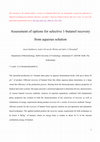
Industrial & Engineering Chemistry Research, 2009
The microbial production of 1-butanol takes place in aqueous fermentation broth, with up to about... more The microbial production of 1-butanol takes place in aqueous fermentation broth, with up to about 20 g . L -1 of product. Efficient recovery of butanol from this dilute aqueous phase determines to a large extent the efficiency of the production process. Starting from the thermodynamic (phase) properties of butanol and water systems, this paper presents a structured approach to determine the key characteristics of various butanol recovery methods. Analysis of reported separations combined with fundamental phase properties has resulted in both the characterization of the selectivity of recovery as well as estimations of energy requirement during product recovery for a variety of recovery methods. Energyefficient systems for the recovery of butanol from aqueous solution are pervaporation and adsorption based techniques. The applied method predicts the recovery energy requirement for both techniques to be below 4 MJ . kg -1 of butanol, which on energy basis is similar to about 10 % of the internal combustion energy of butanol.
Industrial & Engineering Chemistry Research, 2005
In order to facilitate experimental studies on countercurrent reactors, a discrete contacting mod... more In order to facilitate experimental studies on countercurrent reactors, a discrete contacting mode was worked out experimentally and theoretically. Enzymatic hydrolysis of penicillin G to phenylacetic acid and 6-aminopenicillanic acid was carried out in biphasic aqueous organic systems without pH-control. The two phases were countercurrently contacted in a discrete manner, so that equilibrium was reached in each stage. Sets of three and five shake flasks served to mimic equilibrium stages in the countercurrent set-up. It was shown that discrete countercurrent contact leads to the same extent of improvement of the equilibrium conversion as continuous countercurrent contact does, when compared to the batch situation. Therefore discrete experiments may be used to simplify the development of continuous countercurrent reactors.
Enzyme and Microbial Technology, 2005
The aromatic diketone 6R-dihydro-oxoisophorone (DOIP) is an important intermediate in the synthes... more The aromatic diketone 6R-dihydro-oxoisophorone (DOIP) is an important intermediate in the synthesis of some naturally occurring carotenoids. Its preparation via the reduction of 4-oxoisophorone (OIP) by baker's yeast has previously been developed to a pilot-scale process. In this work, the kinetics of substrate inhibition and of product degradation during the reduction of OIP using resting baker's yeast cells as catalyst is studied. Substrate inhibition during the reduction can be described by a non-competitive type of inhibition. Product is degraded to an unwanted by-product 4S,6R-actinol by baker's yeast. This reaction can very well be described by a second-order rate equation with respect to DOIP concentration, which is an exceptional case for a whole-cell-catalyzed reaction system.

Uploads
Papers by Adrie Straathof